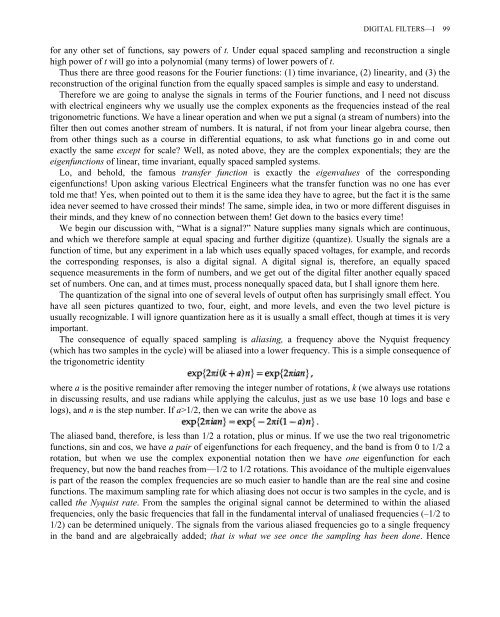hamming
hamming
hamming
You also want an ePaper? Increase the reach of your titles
YUMPU automatically turns print PDFs into web optimized ePapers that Google loves.
DIGITAL FILTERS—I 99for any other set of functions, say powers of t. Under equal spaced sampling and reconstruction a singlehigh power of t will go into a polynomial (many terms) of lower powers of t.Thus there are three good reasons for the Fourier functions: (1) time invariance, (2) linearity, and (3) thereconstruction of the original function from the equally spaced samples is simple and easy to understand.Therefore we are going to analyse the signals in terms of the Fourier functions, and I need not discusswith electrical engineers why we usually use the complex exponents as the frequencies instead of the realtrigonometric functions. We have a linear operation and when we put a signal (a stream of numbers) into thefilter then out comes another stream of numbers. It is natural, if not from your linear algebra course, thenfrom other things such as a course in differential equations, to ask what functions go in and come outexactly the same except for scale? Well, as noted above, they are the complex exponentials; they are theeigenfunctions of linear, time invariant, equally spaced sampled systems.Lo, and behold, the famous transfer function is exactly the eigenvalues of the correspondingeigenfunctions! Upon asking various Electrical Engineers what the transfer function was no one has evertold me that! Yes, when pointed out to them it is the same idea they have to agree, but the fact it is the sameidea never seemed to have crossed their minds! The same, simple idea, in two or more different disguises intheir minds, and they knew of no connection between them! Get down to the basics every time!We begin our discussion with, “What is a signal?” Nature supplies many signals which are continuous,and which we therefore sample at equal spacing and further digitize (quantize). Usually the signals are afunction of time, but any experiment in a lab which uses equally spaced voltages, for example, and recordsthe corresponding responses, is also a digital signal. A digital signal is, therefore, an equally spacedsequence measurements in the form of numbers, and we get out of the digital filter another equally spacedset of numbers. One can, and at times must, process nonequally spaced data, but I shall ignore them here.The quantization of the signal into one of several levels of output often has surprisingly small effect. Youhave all seen pictures quantized to two, four, eight, and more levels, and even the two level picture isusually recognizable. I will ignore quantization here as it is usually a small effect, though at times it is veryimportant.The consequence of equally spaced sampling is aliasing, a frequency above the Nyquist frequency(which has two samples in the cycle) will be aliased into a lower frequency. This is a simple consequence ofthe trigonometric identitywhere a is the positive remainder after removing the integer number of rotations, k (we always use rotationsin discussing results, and use radians while applying the calculus, just as we use base 10 logs and base elogs), and n is the step number. If a>1/2, then we can write the above asThe aliased band, therefore, is less than 1/2 a rotation, plus or minus. If we use the two real trigonometricfunctions, sin and cos, we have a pair of eigenfunctions for each frequency, and the band is from 0 to 1/2 arotation, but when we use the complex exponential notation then we have one eigenfunction for eachfrequency, but now the band reaches from—1/2 to 1/2 rotations. This avoidance of the multiple eigenvaluesis part of the reason the complex frequencies are so much easier to handle than are the real sine and cosinefunctions. The maximum sampling rate for which aliasing does not occur is two samples in the cycle, and iscalled the Nyquist rate. From the samples the original signal cannot be determined to within the aliasedfrequencies, only the basic frequencies that fall in the fundamental interval of unaliased frequencies (–1/2 to1/2) can be determined uniquely. The signals from the various aliased frequencies go to a single frequencyin the band and are algebraically added; that is what we see once the sampling has been done. Hence


